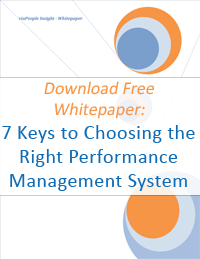Benefits of the 90 Day Performance Review
 The 90 day performance review is conducted by many organizations after an employee (new hire or transferred employee) starts a new position. Some organizations require a 90 day performance review as it marks the end of a formal ‘probationary period’ for new hires but many organizations have adopted the process as a part of sound talent management practice. While it may seem like an additional administrative formality, the 90 day review should be included as an essential step in the onboarding process as it offers employees, managers and the organization several important benefits.
The 90 day performance review is conducted by many organizations after an employee (new hire or transferred employee) starts a new position. Some organizations require a 90 day performance review as it marks the end of a formal ‘probationary period’ for new hires but many organizations have adopted the process as a part of sound talent management practice. While it may seem like an additional administrative formality, the 90 day review should be included as an essential step in the onboarding process as it offers employees, managers and the organization several important benefits.
Benefits of the 90 Day Performance Review
Employee Benefits
Within the first 90 days in a new position, new employees have had an appropriate amount of time to get adjusted to the role and the company. Ideally, they have had a chance to execute on the short-term goals set at the start of the new position, and develop relationships with their co-workers.
- Early Performance Feedback - The 90 day performance review discussion serves as an important 'check-point' for employees on their progress. It provides an opportunity to receive feedback on initial performance, reinforcing the things that are going well and giving them a chance to make changes early. Ultimately, the 90 day review sets the employee up for success in the mid-year or annual performance review.
- Open Forum For Discussion - The start of a new position can bring about uncertainty for all involved. The 90 day performance review offers employees a forum to ask questions of their manager regarding expectations, request resources, and/or express any concerns that they might have surfaced.
Manager Benefits
Ensuring the smooth transition and early success of a new hire in the first 90 days is a key responsibility for managers. While managers should be checking in with new hires on a regular basis, the 90 day performance review is an important assessment point.
- Gauge Future Performance - After 90 days, managers have had ample time to observe the progress made by the new employee. This is the time when managers can gauge the future performance of a new employee and/or determine if the hire may not be the right fit for the position or the organization. There is merit to the old concept of "hire slow, fire fast," as keeping poor performers has broad implications for team morale, customer service and organizational performance. The 90 day performance review provides structure to the process of assessing the potential success of the employee going forward.
- Clarify Performance Goals and Expectations - The 90 day review is a formal opportunity for managers to communicate and clarify performance expectations to ensure that the new employee understands their role and expectations. At this point, the manager and the employee can discuss goals going forward, adjust current goals, and set new goals for the rest of the performance period.
- Deliver Feedback – The 90 day review is the time for managers to deliver feedback on performance observed during this early period. This important feedback should reinforce the positive behaviors and activities that contribute to good performance, as well as offer suggestions in areas that should be improved in the future.
- Build the Employee-Manager Relationship – The 90 day performance review discussion is an important opportunity for managers to continue to build a solid relationship with the employee which is critical to employee engagement over the long term. Read more about how to maximize the 90 day performance review discussion in How Performance Reviews Shape Your Relationships With Your Employees.
Organizational Benefits
The practice of 90 day performance reviews contributes to several important organizational outcomes. The process itself contributes to employee performance and engagement, while the data collected improves talent decision making over the long term.
- Enhanced Performance – As part of an effective and active recruiting process, the 90 day review can decrease the amount of time it takes for new employees to demonstrate competent performance. As stated earlier, 90 days is an appropriate amount of time for employees to get oriented to their role and begin to execute on the short-term objectives. The feedback provided during the 90 day performance review, both positive and constructive, assists employees in improving their performance. Without that essential feedback, new employees can flounder and not realize their full potential as quickly. In addition, the data resulting from a 90 day review can be one of the measures used to determine Time to Competence, an important HR metric.
- Better Hiring Decisions – The success of employees after 90 days can be an insightful indicator of the effectiveness of the hiring process . The data obtained from 90 day reviews (i.e., overall performance and/or competency ratings) can serve as criterion to validate the effectiveness of the selection process being used for a particular position. The data can also be used to compare the effectiveness of recruiting sources and targeted sourcing activities.
Ultimately, the 90 day performance review is not an event or required activity. It is an important leadership tool that contributes to performance and sound HR decision making. Organizations can efficiently and easily implement 90 day reviews using HR software like viaPeople Performance Management solution. Click here to request product information.
Share this
You May Also Like
These Related Stories

Mid-Year Reviews – the New Annual Performance Appraisal?

7 Steps to Becoming a Performance Appraisal Process Rock Star!



